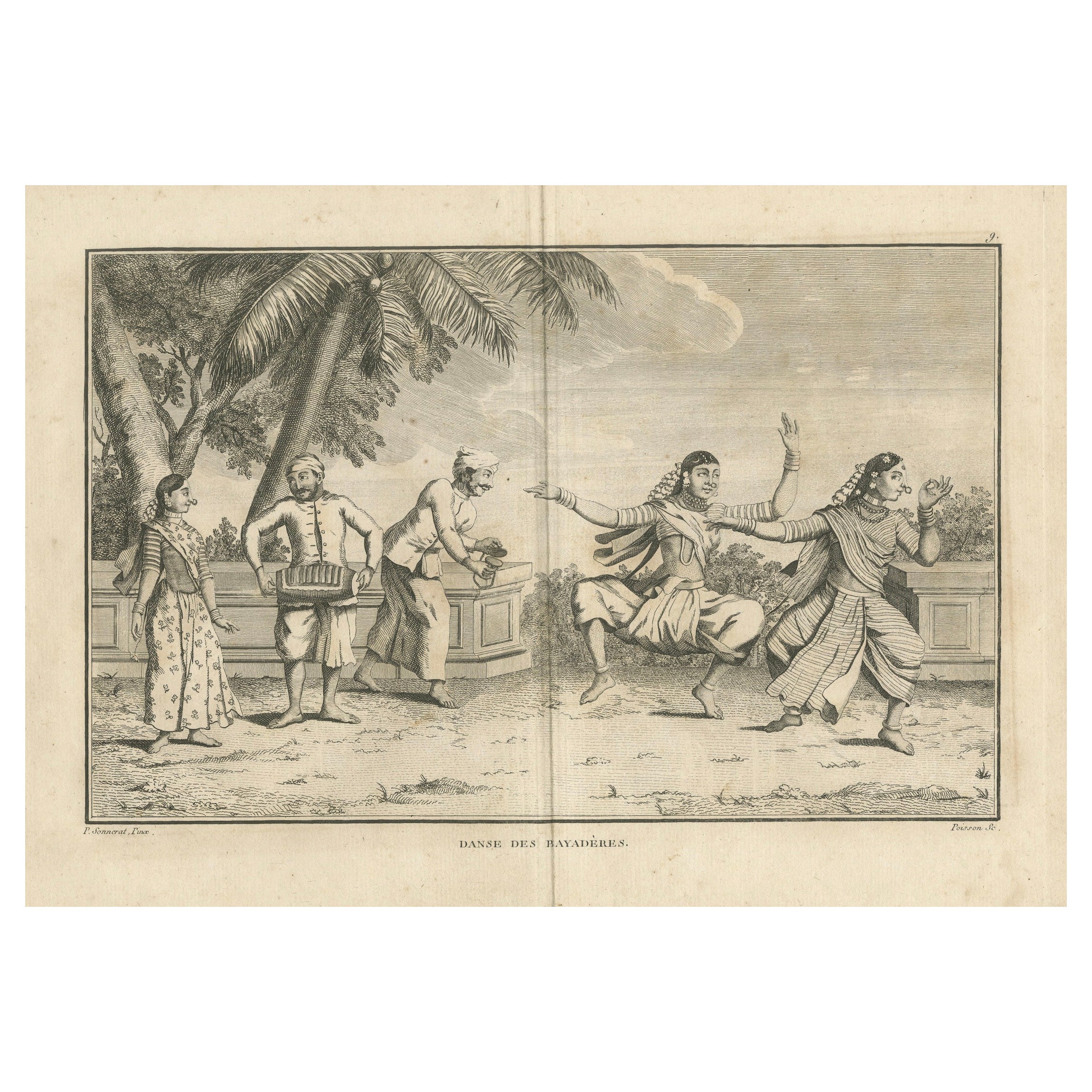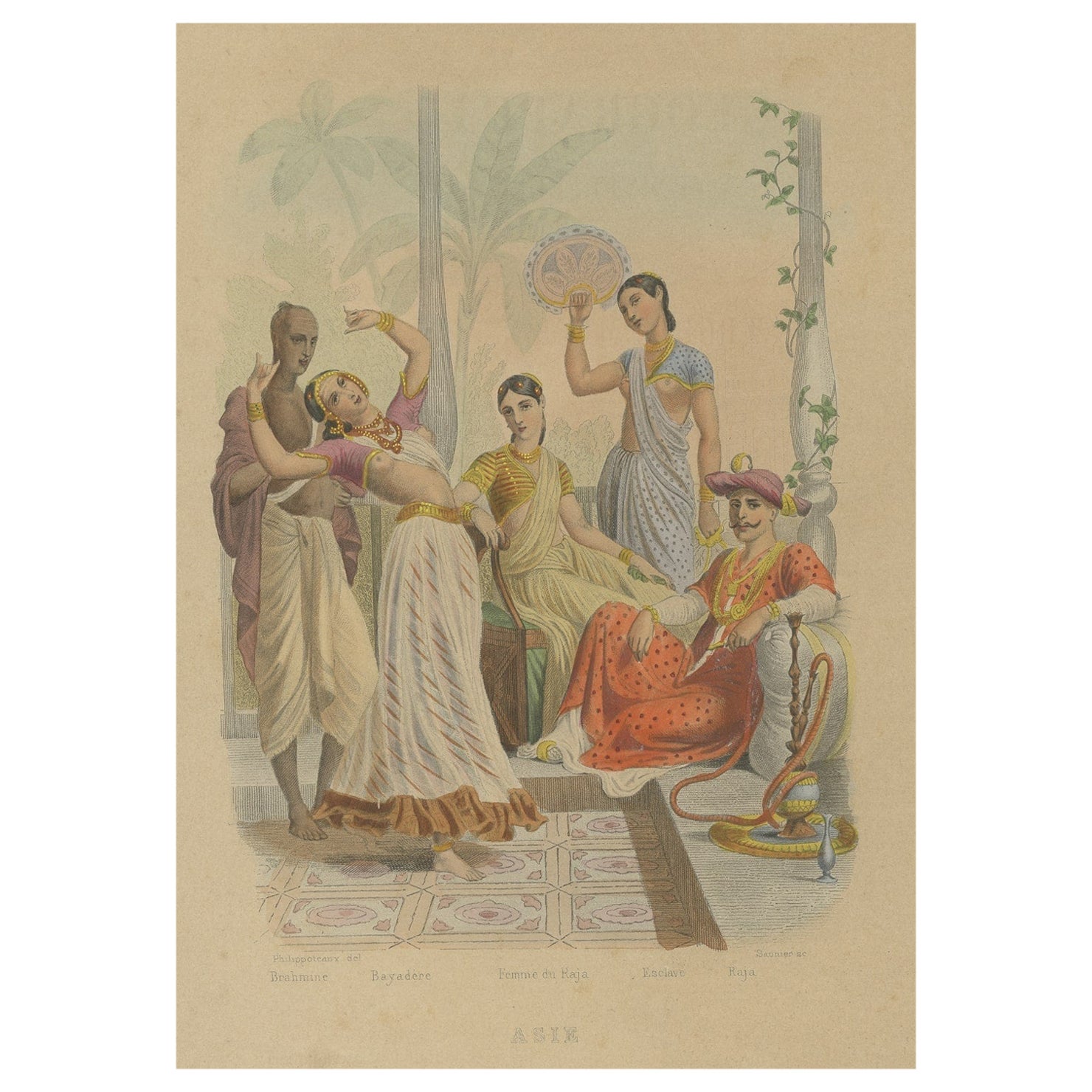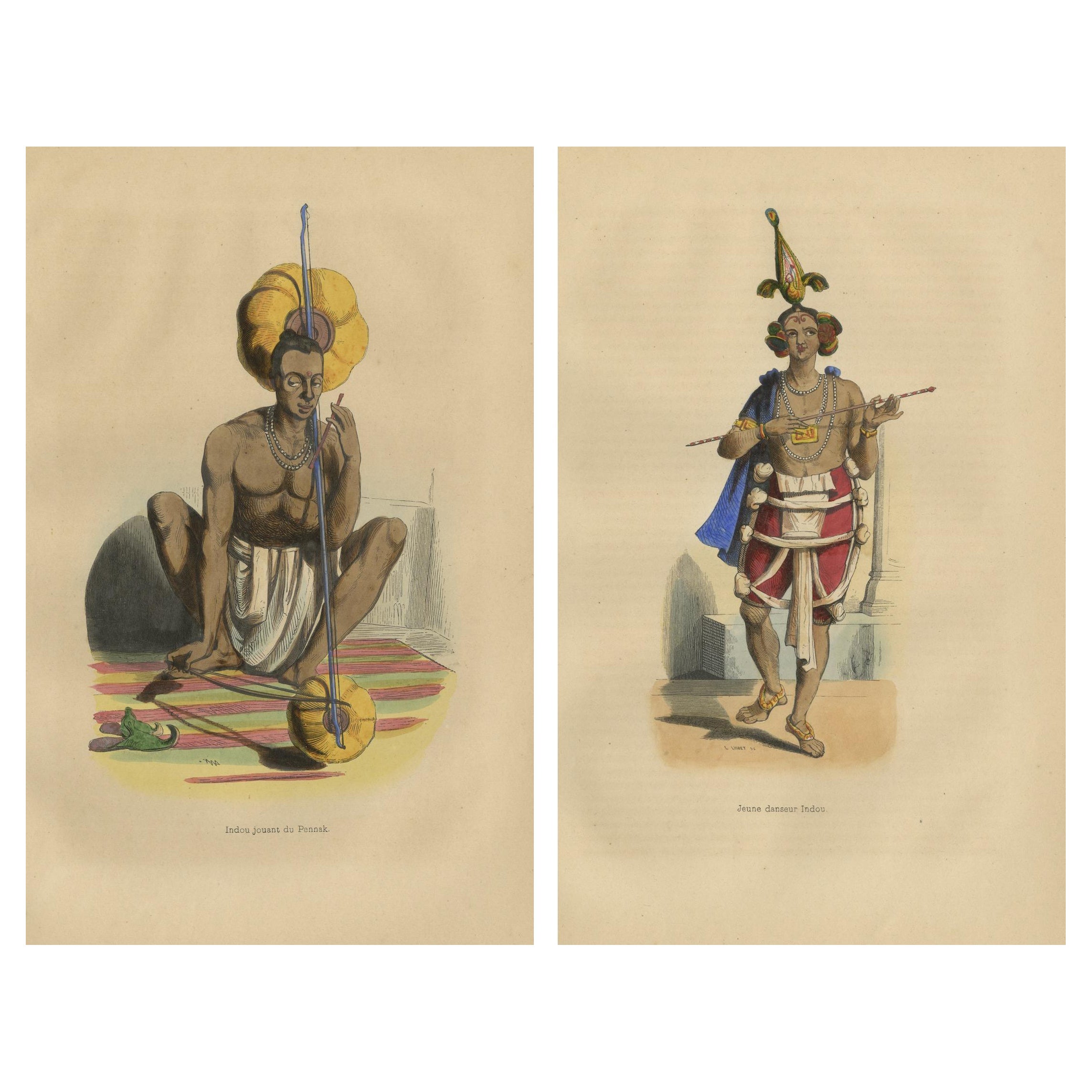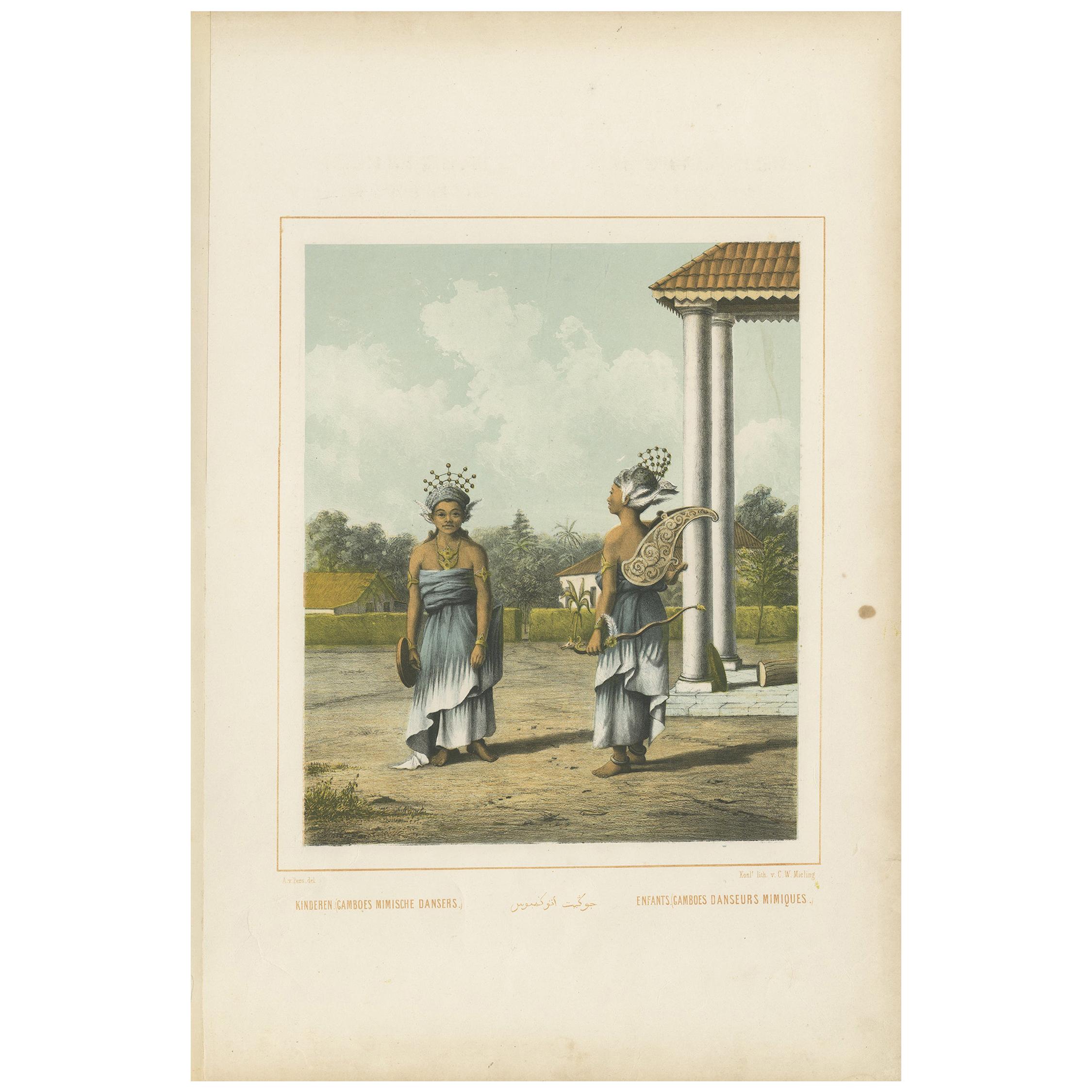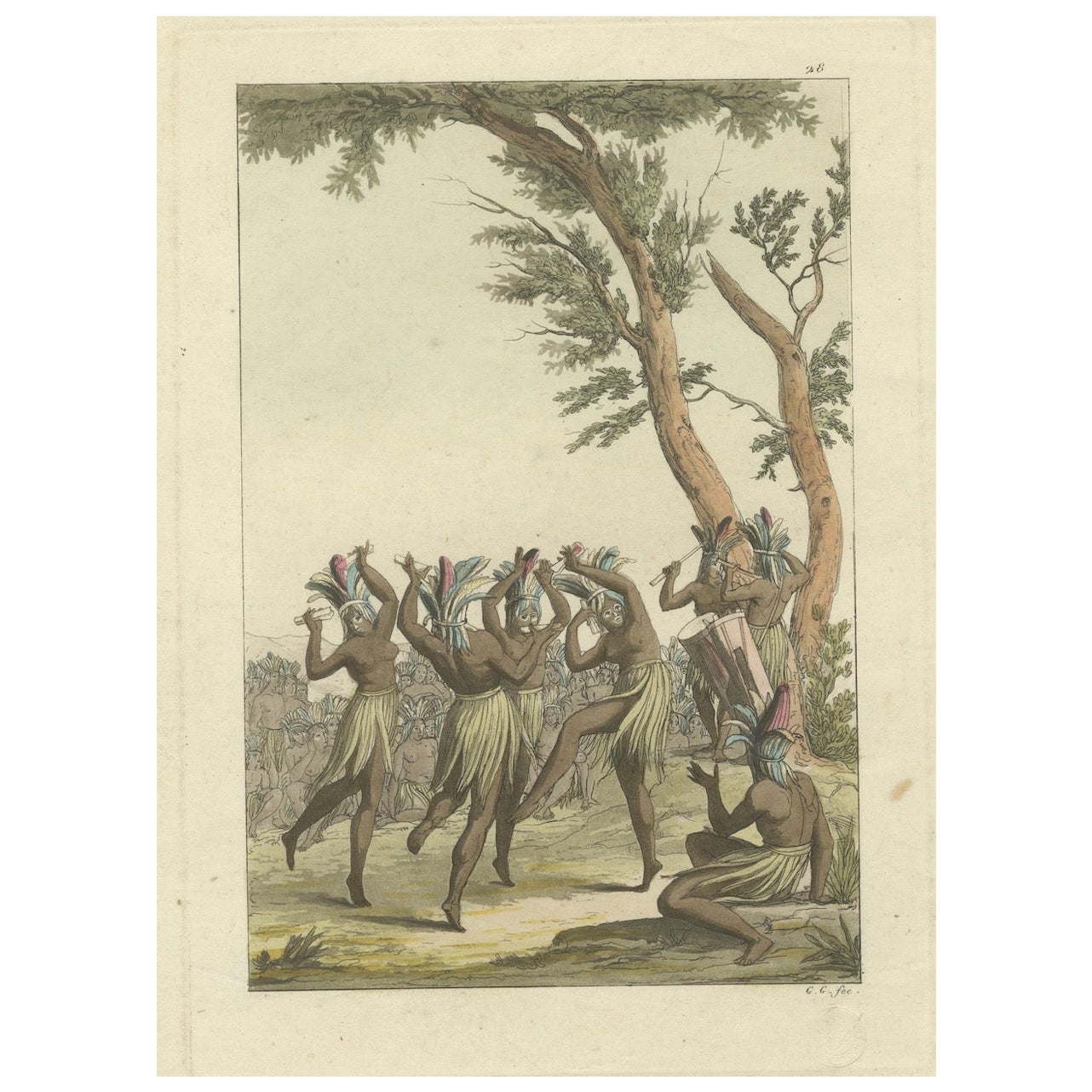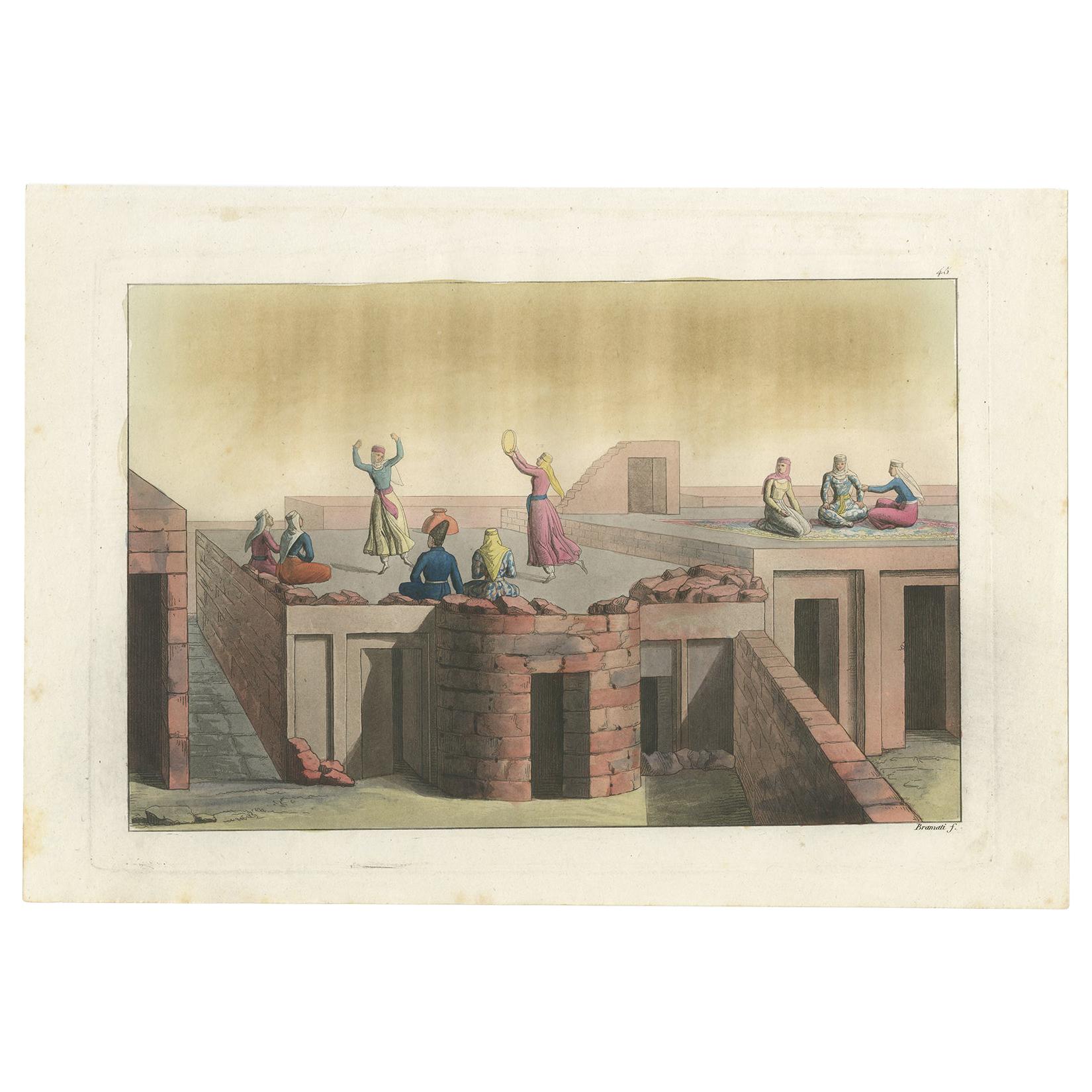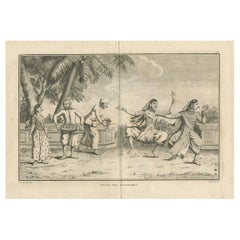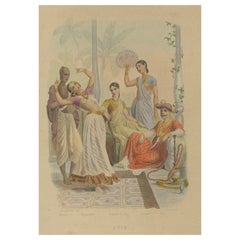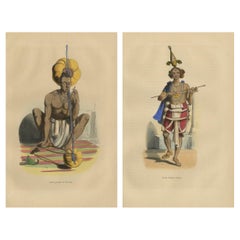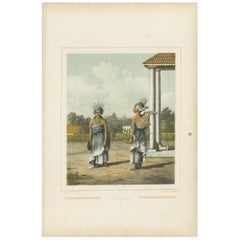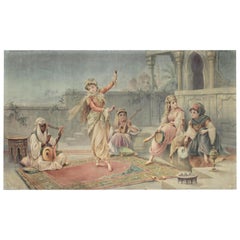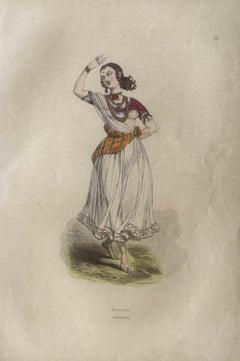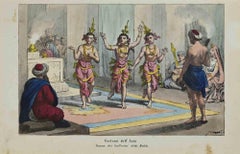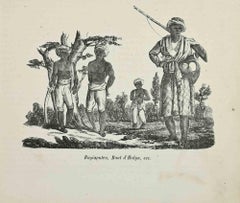Items Similar to Musicians and Bajadere Dancers from Pondicherry, India, ca.1845
Want more images or videos?
Request additional images or videos from the seller
1 of 5
Musicians and Bajadere Dancers from Pondicherry, India, ca.1845
$316.93
$396.1720% Off
£239.02
£298.7820% Off
€272
€34020% Off
CA$438.19
CA$547.7320% Off
A$490.84
A$613.5520% Off
CHF 257.81
CHF 322.2620% Off
MX$5,968.49
MX$7,460.6120% Off
NOK 3,264.69
NOK 4,080.8720% Off
SEK 3,099.07
SEK 3,873.8420% Off
DKK 2,070.64
DKK 2,588.3020% Off
About the Item
Antique print titled 'Bajaderen von Pondichery, Bajadères de Pondichery'.
This print depicts musicians from Pondicherry, India.
Europeans referred to exotic Indian dancers as Bajaderes (French bayadère, from Port. bailadeira – female dancer, nomen agentis from bailar – to dance, from late Latin ballare). Unlike in the native Indian culture, no strict distinction was made between Devadasis (worshippers, temple dancers who were only allowed to perform at church services) and Nautch dancers (who danced for evening, secular entertainment). Bayaderes perform in groups of up to twelve girls at private festivities, accompanied by musicians. Their performances resemble pantomimes and deal with themes from the area of ??love life and the human emotional world. Dancers' clothing and shawls were also called 'Bajaderes' in Europe.
Originates from 'Naturgeschichte und Abbildungen des Menschen der verschiedenen Rassen und Stamme nach den neuesten Entdeckungen und vorzuglichsten Originalien.', by Heinrich Rudolf Schinz.
Artists and Engravers: Heinrich Rudolf Schinz (1777-1861) was a Swiss physician and naturalist. Schinz was born at Zurich and studied medicine at Würzburg and Jena, returning to Zurich in 1798 to practice. In 1804 he became a teacher at the medical institute, and in 1833 he became extraordinary professor of natural history at the university of Zurich.
- Dimensions:Height: 10.24 in (26 cm)Width: 13.98 in (35.5 cm)Depth: 0 in (0.02 mm)
- Materials and Techniques:
- Period:1840-1849
- Date of Manufacture:circa 1845
- Condition:Wear consistent with age and use. Condition: Very good, light foxing. Please study image carefully.
- Seller Location:Langweer, NL
- Reference Number:Seller: BG-10718 1stDibs: LU3054327152152
About the Seller
5.0
Recognized Seller
These prestigious sellers are industry leaders and represent the highest echelon for item quality and design.
Platinum Seller
Premium sellers with a 4.7+ rating and 24-hour response times
Established in 2009
1stDibs seller since 2017
2,517 sales on 1stDibs
Typical response time: <1 hour
- ShippingRetrieving quote...Shipping from: Langweer, Netherlands
- Return Policy
Authenticity Guarantee
In the unlikely event there’s an issue with an item’s authenticity, contact us within 1 year for a full refund. DetailsMoney-Back Guarantee
If your item is not as described, is damaged in transit, or does not arrive, contact us within 7 days for a full refund. Details24-Hour Cancellation
You have a 24-hour grace period in which to reconsider your purchase, with no questions asked.Vetted Professional Sellers
Our world-class sellers must adhere to strict standards for service and quality, maintaining the integrity of our listings.Price-Match Guarantee
If you find that a seller listed the same item for a lower price elsewhere, we’ll match it.Trusted Global Delivery
Our best-in-class carrier network provides specialized shipping options worldwide, including custom delivery.More From This Seller
View AllDance of the Bayadères – Sonnerat Engraving Depicting Indian Temple Dancers 1806
Located in Langweer, NL
Dance of the Bayadères – Sonnerat Engraving Depicting Indian Temple Dancers, 1806
This lively engraving titled *Danse des Bayadères* (Dance of the Bayadères) is plate number 9 from ...
Category
Antique Early 1800s Prints
Materials
Paper
Antique Print of a Brahmin, Rajah, Slave and Other Figures of Asia, c.1870
Located in Langweer, NL
Antique print titled 'Brahmine - Bayadere - Femme du Raja - Esclave - Raja'. Lithograph of a Brahmin, dancer, Rajah, slave and wife of the Rajah. This print originates from 'Ge´ograp...
Category
Antique 19th Century Prints
Materials
Paper
$158 Sale Price
20% Off
1844 Vibrant Indian Cultural Prints: Musician and Dancer Lithographs
Located in Langweer, NL
"1844 Vibrant Indian Cultural Prints: Musician and Dancer Lithographs"
Description:
Explore the rich heritage of India with these 1844 handcoloured ...
Category
Antique 1840s Prints
Materials
Paper
$223 Sale Price / set
20% Off
Antique Print of Indonesian Children dressed up as Dancers, Van Pers circa 1850
Located in Langweer, NL
Antique print titled 'Kinderen (Gamboes) Mimische Dansers - Enfants (Gamboes) Danseurs Mimiques'. Colored lithograph of two Indonesian children dressed ...
Category
Antique Mid-19th Century Prints
Materials
Paper
$559 Sale Price
20% Off
Ritual Dance: Expressions of Cultural Heritage in an African Ceremony, 1827
Located in Langweer, NL
The print is from "Il Costume Antico e Moderno" by Giulio Ferrario, specifically depicting the "Le Lullunge" feast in Senegambia. This festival is illustrated as part of the extensive series detailing the customs, costumes, and daily life of people from different parts of the world. The illustration captures a lively and culturally significant dance that forms part of the "Le Lullunge" celebrations, showcasing traditional attire and communal participation, which are central to the event in Senegambian culture. The illustration not only serves as a vibrant representation of the dance and celebration but also as an ethnographic record from the early 19th century, emphasizing the richness of Senegambian traditions.
The term "Senegambia" historically referred to a region in West Africa that encompassed parts of what are today known as Senegal and The Gambia. This area is known for its rich cultural heritage, including vibrant festivals and communal celebrations like the one depicted in the illustration. The "Le Lullunge" feast, as illustrated in Giulio Ferrario's "Il Costume Antico e Moderno," captures the traditional dances and social practices of the peoples in this West African region.
This original antique hand-colored print depicts a vibrant scene of Native African dance, possibly part of a ceremonial or ritualistic activity. The individuals are animatedly engaged in dance, with their limbs dynamically positioned, suggesting vigorous movement. Each figure is adorned with elaborate feathered headdresses and carries feathers or other items as part of their dance. These accessories likely have cultural significance, possibly denoting status, role in the ceremony, or spiritual symbolism.
The attire of the dancers is simple yet functional for their vigorous activity, consisting of skirts that allow for ease of movement. Their outfits are decorated with additional elements that may indicate tribal affiliation or personal achievement. The dancers are barefoot, connecting them physically and symbolically to the earth, which is a common aspect in many African cultural practices emphasizing a connection to nature.
The setting of the dance is outdoors, under a large tree, indicating the importance of natural surroundings for the event. This could be a communal gathering place, chosen for its significance within their community or for its natural beauty and tranquility.
Overall, this image captures a moment of cultural expression, highlighting the importance of dance in Native African traditions as a form of communication, celebration, or spiritual practice. The detail and color used in the depiction aim to convey the vibrancy and energy of the scene, reflecting the artist’s perspective on these cultural practices.
In more detail:
From: ‘Il Costume Antico e Moderno …, l’America.’ , by Giulio Ferrario, published in Milan in 21 volumes by Antonio Fortunato Stella in 1827 (first edition, second issue). The 17 volumes of the first issue were published sequentially between c. 1815/1816 until 1826 after first being issued in 143 weekly installments. The work appeared in Italian and French. Smaller size editions with smaller much less elaborate plates were published in Florence (1823-38), Naples (1831-42) and even a 16mo. editon in Livorno (1830). Original blindstamp at bottom right image. The sources used for this work are wide.
Made by ‘Gallo Gallina’ after ‘Giulio Ferrario’. Giulio Ferrario was founder of the ‘Societa Tipografica de Classici Italiani’ and served as the director of the Braidense National Library in Milan, Italy. Artists that worked on this monumental work are: Gallo Gallina, D.K. Bonatti, A. Biasioli, L. Rossi, Paolo Fumagalli, Gaetano Zancon (1771-1816), G. Bigatti, C. Bramati, G. Gallo, C. Bottiglia, G. Castellini, Antonio Rancati (1784-1816), Vittorio Raineri, Sydney Parkinson...
Category
Antique 1820s Prints
Materials
Paper
$233 Sale Price
20% Off
Antique Print of Dancing Natives of Georgia by Ferrario '1831'
Located in Langweer, NL
Original antique print of natives of Georgia, dancing. This print originates from 'Costume Antico e Moderno: Palestine, China, India, Oceania' by Ferrario. Published 1831.
Category
Antique Mid-19th Century Prints
Materials
Paper
$233 Sale Price
20% Off
You May Also Like
Large Antique Anglo-Indian Painting on Woven Fabric Portraying A Female Dancer
Located in Hamilton, Ontario
This very large and well executed painting on a woven fabric is unsigned and likely done by a European artist in the late 19th century or early 20th century. The painting is done in ...
Category
Antique Late 19th Century English Anglo-Indian Paintings
Materials
Fabric
$2,500 Sale Price
57% Off
Uses and Customs - Indian Dancer - Lithograph - 1862
Located in Roma, IT
Uses and Customs - Indian Dancer is a lithograph on paper realized in 1862.
The artwork belongs to the Suite Uses and customs of all the peoples of the universe: " History of the go...
Category
1860s Modern Figurative Prints
Materials
Lithograph
Balok Dancers - Lithograph - 1862
Located in Roma, IT
Customs -Balok Dancers is a Hand-colored lithograph on paper realized in 1862.
Titled on the lower.
The artwork belongs to the Suite Uses and customs of all the peoples of the univ...
Category
1860s Modern Figurative Prints
Materials
Lithograph
Customs - Rajput - Lithograph - 1862
Located in Roma, IT
Customs - Rajput is a Hand-colored lithograph on paper realized in 1862.
Titled on the lower.
The artwork belongs to the Suite Uses and customs of all the peoples of the universe :...
Category
1860s Modern Figurative Prints
Materials
Lithograph
Ram Genie Dance - Lithograph - 1862
Located in Roma, IT
Customs -Ram Genie Dance is a Hand-colored lithograph on paper realized in 1862.
Titled on the lower.
The artwork belongs to the Suite Uses and customs of all the peoples of the un...
Category
1860s Modern Figurative Prints
Materials
Lithograph
The Music Party, 19th Century Company School Watercolour
Located in London, GB
COMPANY SCHOOL
19th Century
The Music Party
Watercolour
Image size: 4 ¾ x 7 ½ inches
Acid free mount
Category
19th Century Victorian Figurative Drawings and Watercolors
Materials
Watercolor
More Ways To Browse
India Musicians
Antique Furniture Pondicherry
Dragonfly Japanese
Dutch Renaissance Cabinet
Elephant Bowl
Empire Secretary Desk
Enamel Silver Compact
English Arts And Crafts Pottery
English Door Knob
English Secretary Glass
Ettore Sottsass Totem
Facto Paris
Fox Terrier
French Inlaid Bombe Chest
French Louis Xvi Style Black Lacquered
French Oil Jars
French Olive Jars
French Wood Pitcher
